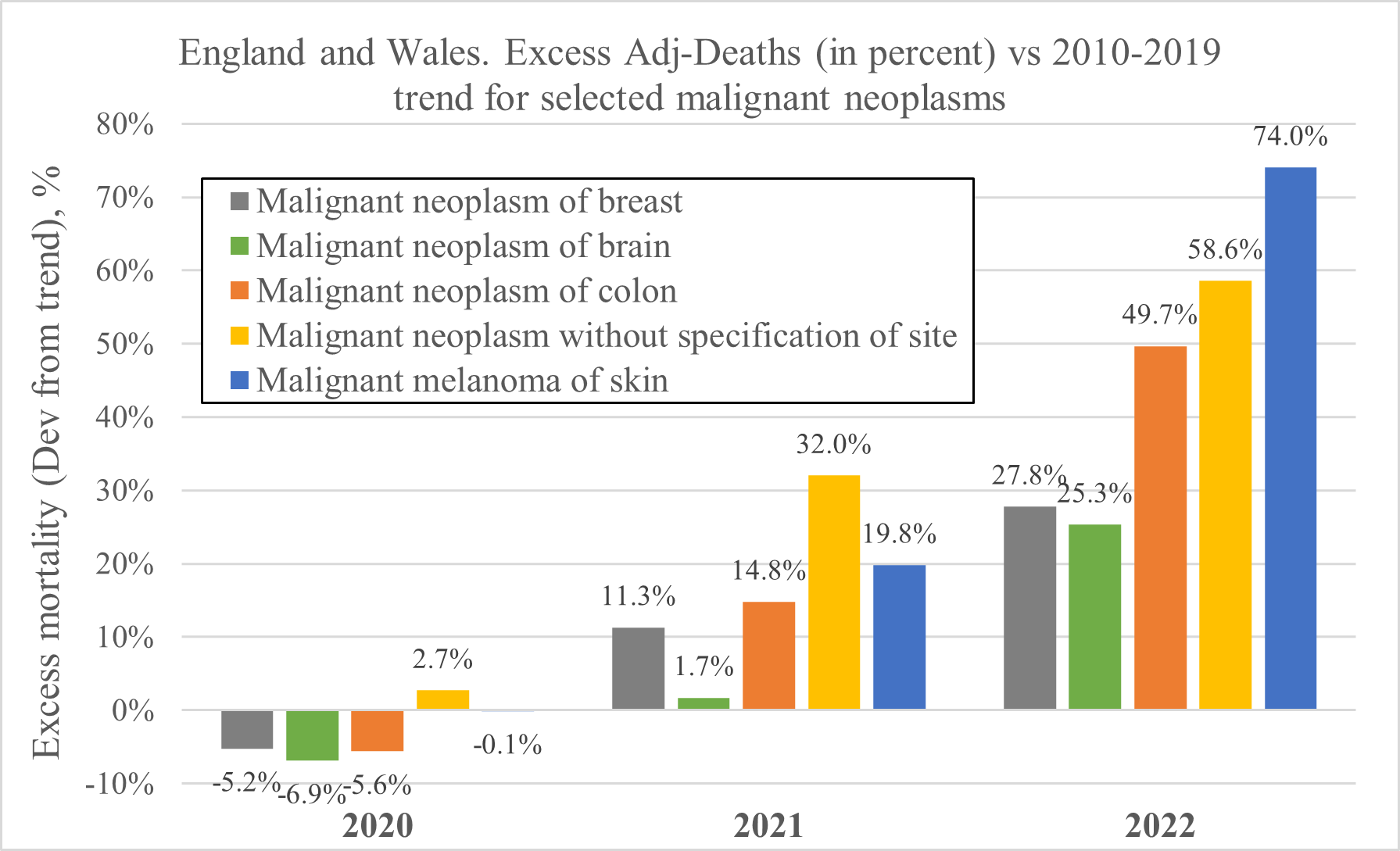Update Date: October - 2023
Carlos Alegria
Download full report (pdf) PDF Report
Navigation to related reports:
Country: UK
Period: Yearly data from 2010 to 2022.
Cause of Death Data
The data used in this analysis is the number of deaths that occurred in England and Wales between 2010 and
2022, by underlying cause code (ICD-10), sex, and age group (up to 90+). The source is the UK Office for
National Statistics (ONS). The direct links to the mortality data by cause for 2010 to 2021 and 2022 are listed
below:
Link to the ONS 2022 data source: Death occurrences by sex, five year age group and underlying cause (ICD-10 code) England and Wales: 2022
Link to the ONS 2010-2021 data source: Death occurrences by sex, five year age group and underlying cause (ICD-10 code) England and Wales: 2010-2021
UK Monthly Registered Deaths (All cause) Deaths registered monthly in England and Wales
Information regarding ONS cause of death statistics:
Analysis of some individual malignant neoplasms:
Malignant neoplasms of breast.
Malignant neoplasms without specification of site.
Malignant neoplasms of skin.
Malignant neoplasms of colon.
Malignant neoplasms of pancreas.
Malignant neoplasms of brain.
| Breast | Without site specification | Colon | Skin | Pancreas |
|---|---|---|---|---|
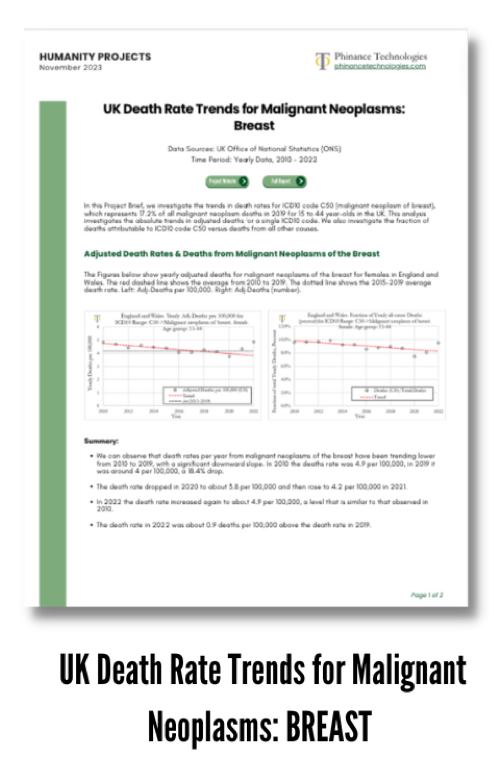
|
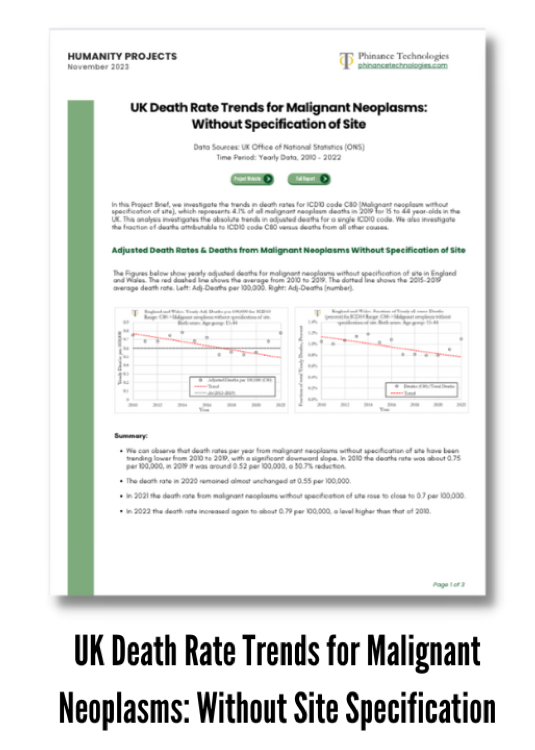
|
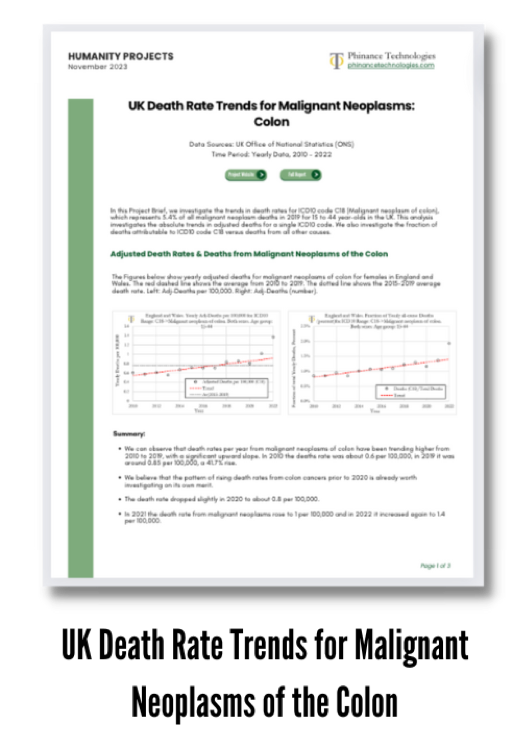
|
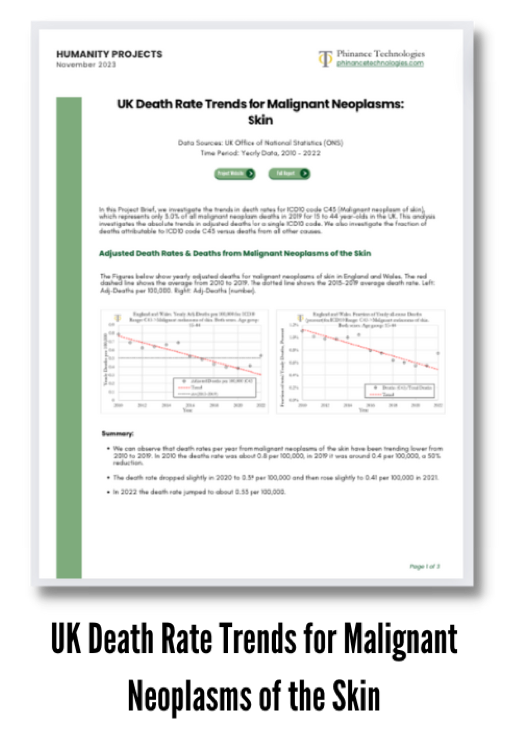
|
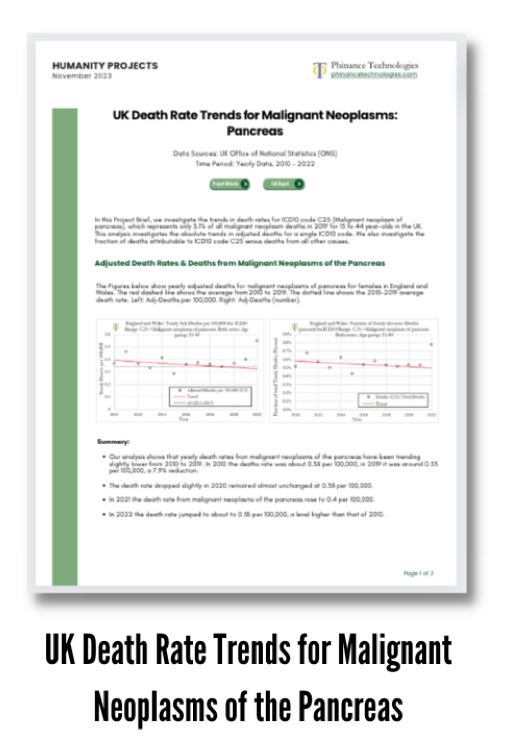
|
Project briefs (pdfs) for individuals malignant neoplasm death analysis |
In this section we investigate the trends in death rates for ICD10 code C50 (malignant neoplasm of breast), which represents 17.2% of all malignant neoplasm deaths in 2019 for 15 to 44 year-olds in the UK. This analysis investigates the absolute trends in adjusted deaths for a single ICD10 code. We also investigate the fraction of deaths attributable to ICD10 code C50 versus deaths from all other causes.
The methdology for establishing the baseline is described in full report.
The Figures below show yearly adjusted deaths for malignant neoplasms of the breast for females in England and Wales. The red dashed line shows the average from 2010 to 2019. The dotted line shows the 2015-2019 average death rate. Left: Adj-Deaths per 100,000. Right: Adj-Deaths (number).
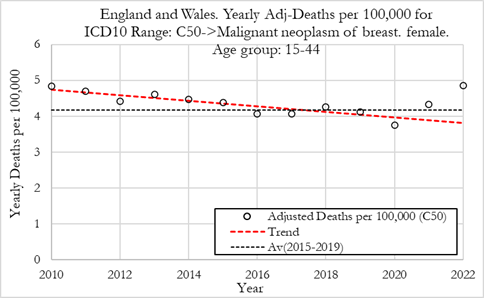
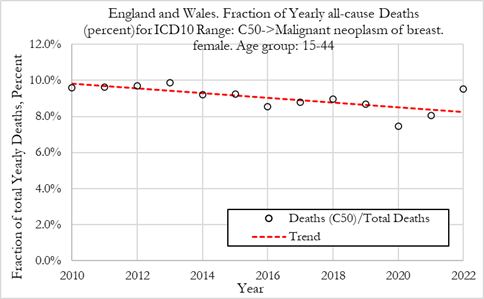
Summary:
In the Figure (left) below we can observe that the excess deaths rates from malignant neoplasms of the breast were -5% in 2020, then rose to about 12% in 2021 and about 28% in 2022. In terms of statistical significance of the excess deaths, we observe from the Figure (right) that for breast cancers, the Z-score in 2020 was only about -2, which is not a strong negative signal but perhaps something worth investigating in further detail. We speculate that perhaps the Covid-19 pandemic measures, lifestyle changes or misclassification of breast cancer deaths as Covid-19 deaths led to fewer breast cancer deaths.
When looking at changes in the fraction of all deaths attributed to breast cancers, we observe that breast cancer rates were about 12% lower, with a -4 Z-score which points to a strong effect and corroborates the previous observations.
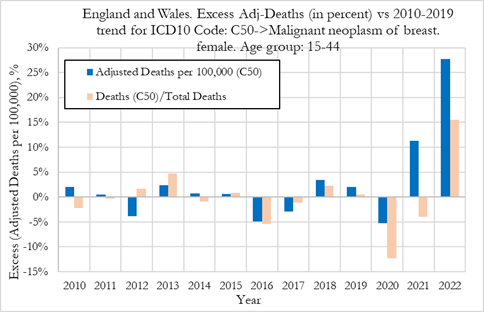
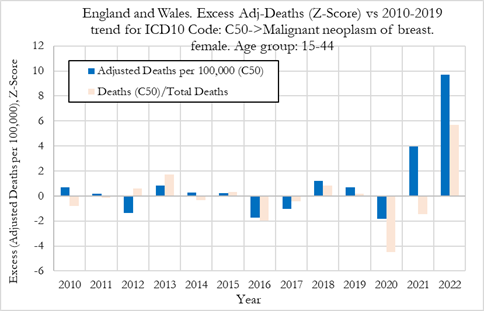
Summary:
In this section we investigate the trends in death rates for ICD10 code C80 (Malignant neoplasm without specification of site), which represents 4.1% of all malignant neoplasm deaths in 2019 for 15 to 44 year-olds in the UK. This analysis investigates the absolute trends in adjusted deaths for a single ICD10 code. We also investigate the fraction of deaths attributable to ICD10 code C80 versus deaths from all other causes. The methdology for establishing the baseline is described in full report.
The Figures below show yearly adjusted deaths for malignant neoplasms without specification of site in England and Wales. The red dashed line shows the average from 2010 to 2019. The dotted line shows the 2015-2019 average death rate. Left: Adj-Deaths per 100,000. Right: Adj-Deaths (number).
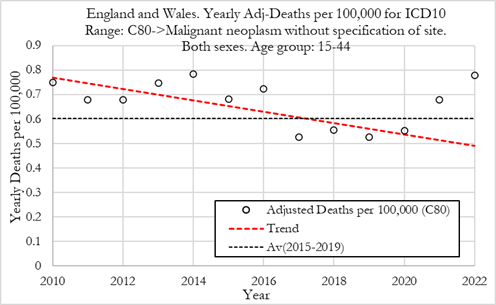

Summary:
In the Figure (left) below we can observe that the excess deaths rates from malignant neoplasms without specification of site were close to zero in 2020, then rose to about +32% in 2021 and about +59% in 2022. In terms of statistical significance of the excess deaths, we observe from the Figure (right) below that for cancers without specification of site, in 2020 the Z-score for adjusted death rates was low, which point to low statistical significance. In 2021 the Z-score was about 3.1, which is a strong signal in statistical terms. In 2022 the Z-score was close to 6, which is a very strong signal and indicates that the excess deaths from these cancers are statistically significant deviations from the 2010-2019 trend.
When looking at changes in the fraction of all deaths attributed to cancers without specification of site, we observe that the fraction of deaths from these cancers were slightly below trend in 2020 and at 13% above trend for 2021 (with low statistical significance). In 2022 however, the fraction of deaths for these cancers jumped about 42%, with a Z-score of above 4, indicating very high statistical significance. It appears that deaths from cancers without specification of site as a fraction of all deaths deviated significantly from prior trends in 2022.
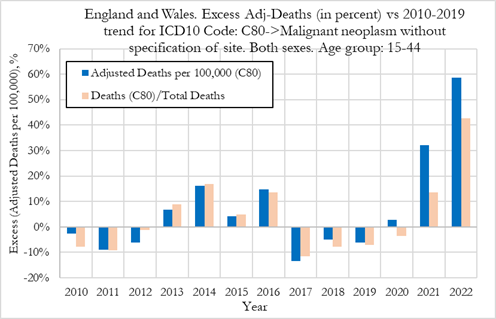
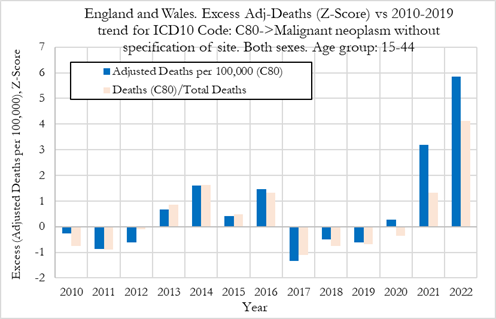
Summary:
We now compare excess deaths rates from malignant neoplasms without site specification for males and females aged 15-44, as shown in the Figure below.
We observe that in 2020 both males and females showed no noticeable excess mortality, with respective Z-scores close to zero (low statistical significance). However, in 2021 women suffered much worse outcomes than men, with women experiencing about 60% deviation from trend, compared to about 10% for men. In 2021 the signal strength for men was weak (with a Z-score below 1) but for women the deviation from trend had very high statistical significance (with a Z-score close to 5), as shown in the Figure (right).
In 2022 the signal strengths for both women and men were very strong (with a Z-score of above 4), with the deviation from trend of being 55% for women and 60% for men.
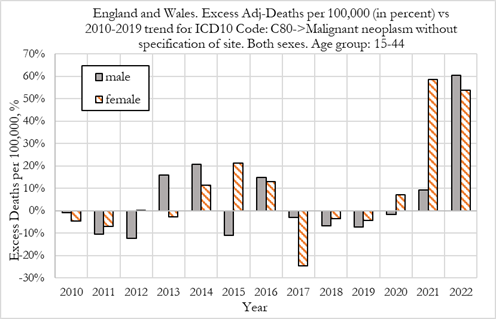

Summary:
In this section we investigate the trends in death rates for ICD10 code C43 (Malignant neoplasm of skin), which represents only 3.0% of all malignant neoplasm deaths in 2019 for 15 to 44 year-olds in the UK. This analysis investigates the absolute trends in adjusted deaths for a single ICD10 code. We also investigate the fraction of deaths attributable to ICD10 code C43 versus deaths from all other causes. The methdology for establishing the baseline is described in full report.
The Figures below show yearly adjusted deaths for malignant neoplasms of skin in England and Wales. The red dashed line shows the average from 2010 to 2019. The dotted line shows the 2015-2019 average death rate. Left: Adj-Deaths per 100,000. Right: Adj-Deaths (number).
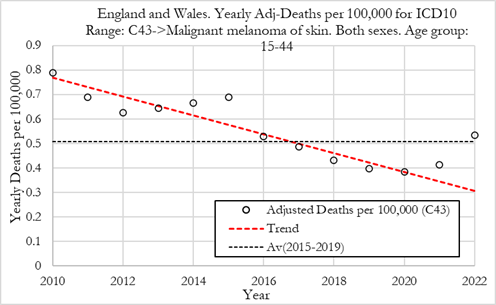
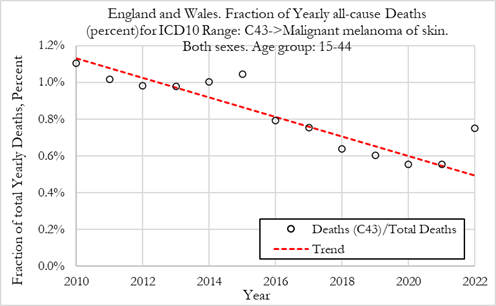
Summary:
In the Figure below (left) we can observe that the excess deaths rates from malignant neoplasms of skin were about zero in 2020, +20% in 2021, and about +75% in 2022. In terms of statistical significance of the excess deaths, we observe from the Figure (right) that for cancers of skin, in 2020 the Z-score for adjusted death rates was zero. In 2021 the Z-score was close to 2.2, which is a weak signal in statistical terms. In 2022 the Z-score was above 8, which is a very strong signal and indicates that the excess deaths from skin cancers are statistically significant deviations from the 2010-2019 trend.
When looking at changes in the fraction of all deaths attributed to cancers of skin, we observe that the fraction of deaths for these cancers were below trend in 2020 and slightly above trend 2021 (but with low statistical significance). In 2022 however, the fraction of deaths for these cancers jumped about 52%, with a Z-score close to 6, indicating very high statistical significance. It appears that cancers of the skin as a fraction of all deaths deviated significantly from prior trends in 2022.
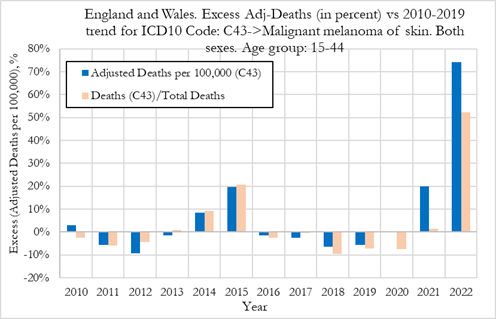
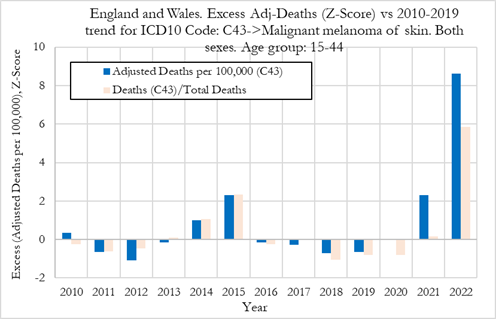
Summary:
We now compare excess deaths rates from malignant neoplasms of skin for males and females aged 15-44, as shown in the Figure below.
When comparing excess death rates attributed to malignant neoplasms of skin for males and females, shown in the Figure below (left), we observe that in 2020, 2021 females showed no noticeable excess mortality, with respective Z-scores close to zero (low statistical significance). In 2022 however, women experienced about +35% deviation from trend with high statistical significance (with a Z-score around 3).
Men suffered rising excess death rates from malignant neoplasms of the skin of about 15% in 2020 and 35% in 2021. The signal strength for men in 2020 was weak (with a Z-score about to 1.5), and in 2021 the signal was strong enough to warrant further investigation (with a Z-score about to 3), as shown in the Figure (right). In 2022 the signal strength for men was very strong (with a Z-score close to 11), with the deviation from trend of being close to 120%.
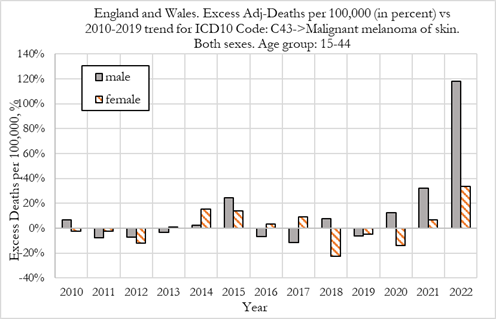
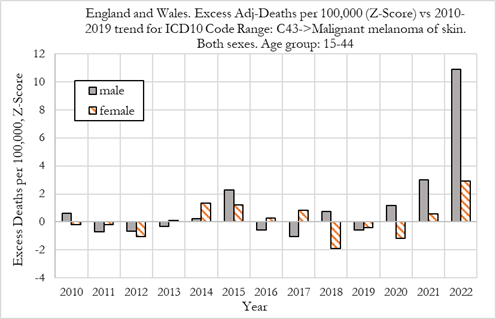
Summary:
In this section we investigate the trends in death rates for ICD10 code C18 (Malignant neoplasm of colon), which represents 5.4% of all malignant neoplasm deaths in 2019 for 15 to 44 year-olds in the UK. This analysis investigates the absolute trends in adjusted deaths for a single ICD10 code. We also investigate the fraction of deaths attributable to ICD10 code C18 versus deaths from all other causes.
The methdology for establishing the baseline is described in full report.
The Figures below show yearly adjusted deaths for malignant neoplasms of colon in England and Wales. The red dashed line shows the average from 2010 to 2019. The dotted line shows the 2015-2019 average death rate. Left: Adj-Deaths per 100,000. Right: Adj-Deaths (number).
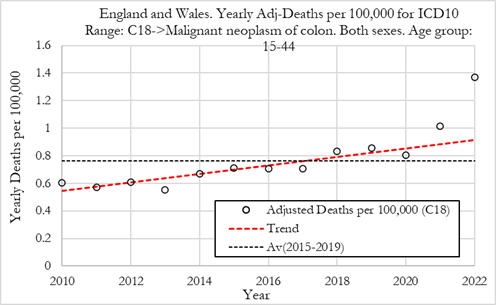
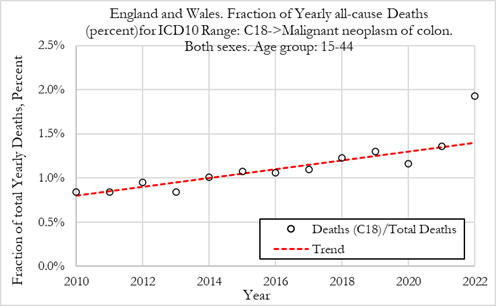
Summary:
In the Figure below (left) we can observe that the excess deaths rates from malignant neoplasms of the colon were -5% in 2020, then rose to about +15% in 2021 and about +50% in 2022. In terms of statistical significance of the excess deaths, we observe from the Figure (right) that for colon cancers, in 2020 the Z-score for adjusted death rates was low, which point to low statistical significance. In 2021 the Z-score was about 2, which is a weak signal in statistical terms. In 2022 the Z-score was above 7, which is a very strong signal and indicates that the excess deaths from colon cancers are statistically significant deviations from the 2010-2019 trend.
When looking at changes in the fraction of all deaths attributed to colon cancers, we observe that the fraction of deaths for these cancers were about 10% below trend in 2020 and at trend for 2021. In 2022 however, the fraction of deaths for these cancers jumped about 37%, with a Z-score of above 7, indicating very high statistical significance. It appears that colon cancers as a fraction of all deaths deviated significantly from prior trends in 2022.
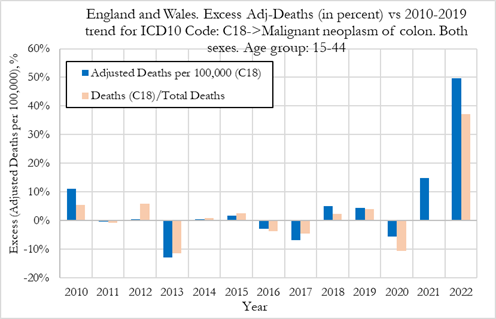
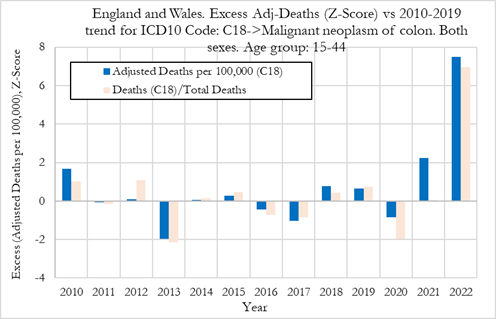
Summary:
When comparing excess death rates attributed to malignant neoplasms of the colon for males and females, shown in the Figure below, we observe that in 2020 both males and females showed no noticeable excess mortality, with respective Z-scores close or above -1 (low statistical significance).
In both 2021 and 2022 men suffered much worse outcomes than women, with men experiencing about 19.5% and 55% deviations from trend in 2021 and 2022 respectively, compared to about 10% and 41% for women.
In 2021 the signal strength for men was weak (with a Z-score of 2.1) and for women the deviation from trend had low statistical significance (with a Z-score of 1.1), as shown in the Figure (right). In 2022 the signal strength for men was very strong (with a Z-score of 6.4) but for women the deviation from trend shows low statistical significance (with a Z-score of 5), as shown in the Figure (right).
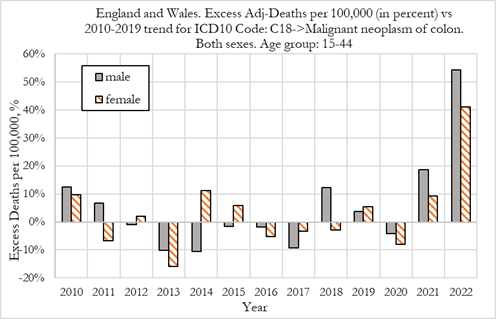

Summary:
In this section we investigate the trends in death rates for ICD10 code C25 (Malignant neoplasm of pancreas), which represents only 3.1% of all malignant neoplasm deaths in 2019 for 15 to 44 year-olds in the UK. This analysis investigates the absolute trends in adjusted deaths for a single ICD10 code. We also investigate the fraction of deaths attributable to ICD10 code C25 versus deaths from all other causes.
The Figures below show yearly adjusted deaths for malignant neoplasms of pancreas in England and Wales. The red dashed line shows the average from 2010 to 2019. The dotted line shows the 2015-2019 average death rate. Left: Adj-Deaths per 100,000. Right: Adj-Deaths (number).
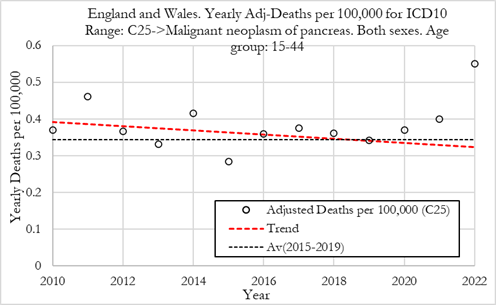

Summary:
In the Figure below (left) we can observe that the excess deaths rates from malignant neoplasms of pancreas were close to zero in 2020, then rose to about +20% in 2021 and about +70% in 2022. In terms of statistical significance of the excess deaths, we observe from the Figure (right) that for cancers of pancreas, in 2020 the Z-score for adjusted death rates was low, which point to low statistical significance. In 2021 the Z-score was close to 2, which is a weak signal in statistical terms. In 2022 the Z-score was 6, which is a very strong signal and indicates that the excess deaths from cancers of the pancreas are statistically significant deviations from the 2010-2019 trend.
When looking at changes in the fraction of all deaths attributed to cancers of pancreas, we observe that the fraction of deaths for these cancers were close to trend in 2020 and 2021 (slightly above trend but with low statistical significance). In 2022 however, the fraction of deaths for these cancers jumped about 55%, with a Z-score of above 4, indicating very high statistical significance. It appears that pancreas cancers as a fraction of all deaths deviated significantly from prior trends in 2022.
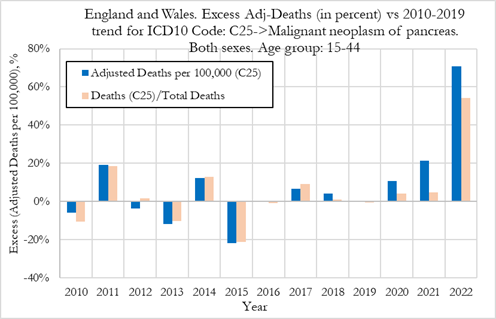
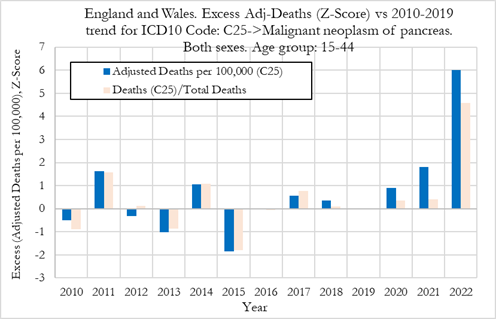
Summary:
We now compare excess deaths rates from malignant neoplasms of pancreas for males and females aged 15-44, as shown in the Figure below.
When comparing excess death rates attributed to malignant neoplasms of pancreas for males and females, shown in the Figure below, we observe that in 2020 both males and females showed no noticeable excess mortality, with respective Z-scores close to zero (low statistical significance).
In 2021 men suffered much worse outcomes than women, with men experiencing about 40% deviation from trend, compared to about -5% for women. In 2021 the signal strength for men was strong enough to warrant further investigation (with a Z-score close to 2.5) but for women the deviation from trend was statistically insignificant (with a Z-score close to zero), as shown in the Figure (right). In 2022 the signal strengths for both men and women were strong (with a Z-score of above 3), with the deviation from trend of being 60% for men and 85% for women.
Malignant neoplasms of the pancreas appear to have accelerated in 2022 for both males and females. However, an interesting observation is that these cancers also started rising in 2021 for men, which we believe should also be subject to further research by medical doctors.
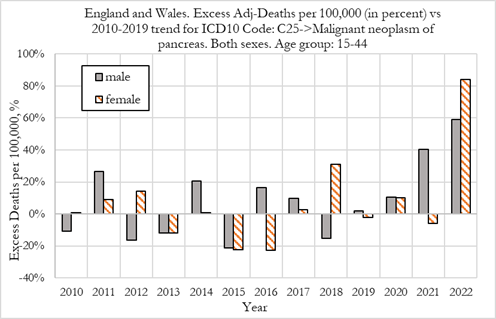
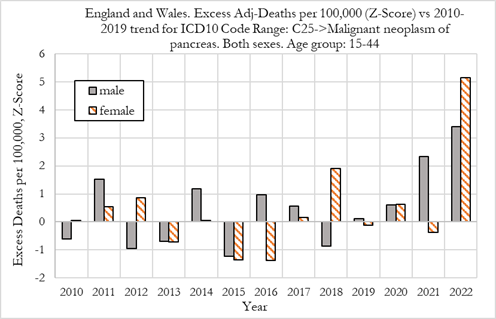
Summary:
In this section we investigate the trends in death rates for ICD10 code C71 (Malignant neoplasm of brain), which represents 10.2% of all malignant neoplasm deaths in 2019 for 15 to 44 year-olds in the UK (2nd most common). This analysis investigates the absolute trends in adjusted deaths for a single ICD10 code. We also investigate the fraction of deaths attributable to ICD10 code C71 versus deaths from all other causes.
The Figures below show yearly adjusted deaths for malignant neoplasms of brain in England and Wales. The red dashed line shows the average from 2010 to 2019. The dotted line shows the 2015-2019 average death rate. Left: Adj-Deaths per 100,000. Right: Adj-Deaths (number).
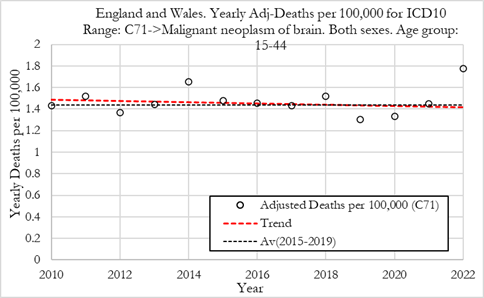
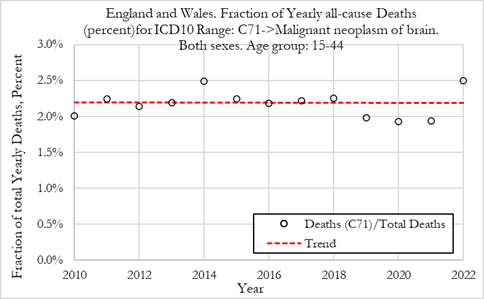
Summary:
In Figure below (left) we can observe that the excess deaths rates from malignant neoplasms of the brain were -7% in 2020, then rose to about +1.5% in 2021, and about 25% in 2022. In terms of statistical significance of the excess deaths, we observe from Figure (right) that for brain cancers, in 2020 and 2021, the Z-scores for adjusted death rates were low, which point to low statistical significance. In 2022 the Z-score rose to about 4, which is a strong signal and indicates that the excess deaths from brain cancers are statistically significant deviations from the 2010-2019 trend.
When looking at changes in the fraction of all deaths attributed to brain cancers, we observe that the fraction of deaths for these cancers was about 12% below trend in both in 2020 and 2021 (with a negative Z-score indicating low statistical significance). In 2022, however, the fraction of deaths for these cancers jumped about 14%, with a Z-score of about 2, also indicating low statistical significance. It appears that brain cancers as a fraction of all deaths did not deviate significantly from prior trends.

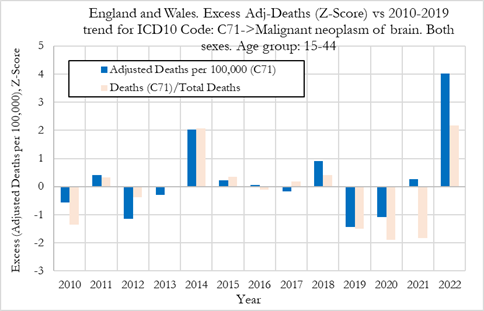
Summary:
We now compare excess deaths rates from malignant neoplasms of brain for males and females aged 15-44, as shown in the Figure below.
When comparing excess death rates attributed to malignant neoplasms of the brain for males and females, we observe that in 2020 and 2021 both males and females showed no noticeable excess mortality, with respective Z-scores close or below 1 (low statistical significance).
In 2022 men suffered much worse outcomes than women, with men experiencing about 35% deviation from trend, compared to about 12% for women. The signal strength for men was very strong (with a Z-score of 4.1) but for women the deviation from trend shows low statistical significance (with a Z-score of 1.4).
Malignant neoplasms of the brain appear to impact males predominantly, which we believe should be subject to further research by medical doctors.

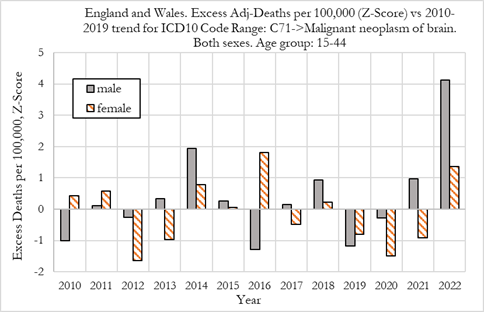
Summary:
The chart below shows an overview of the excess mortality for selected malignant neoplasms, which are analysed in detail in the full report.
